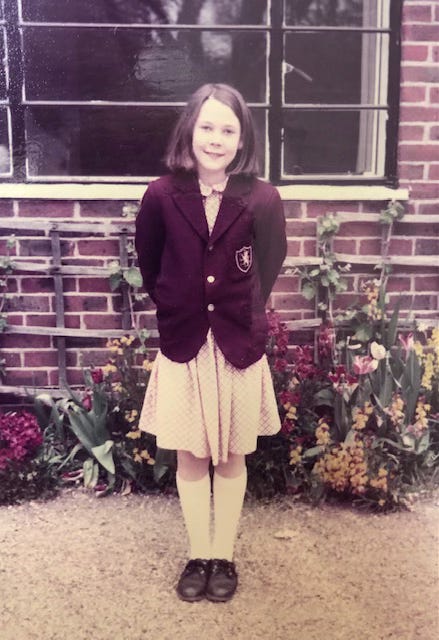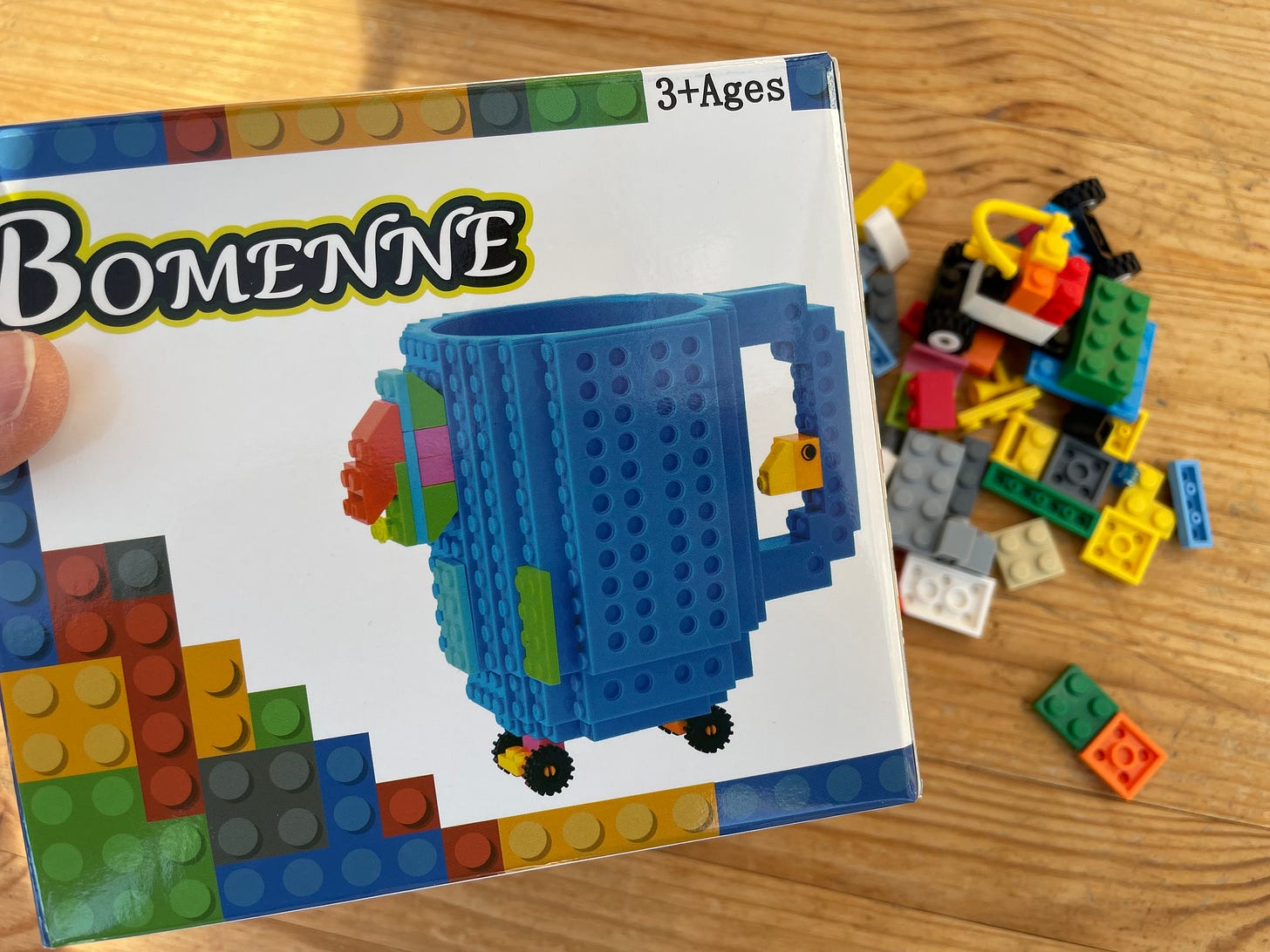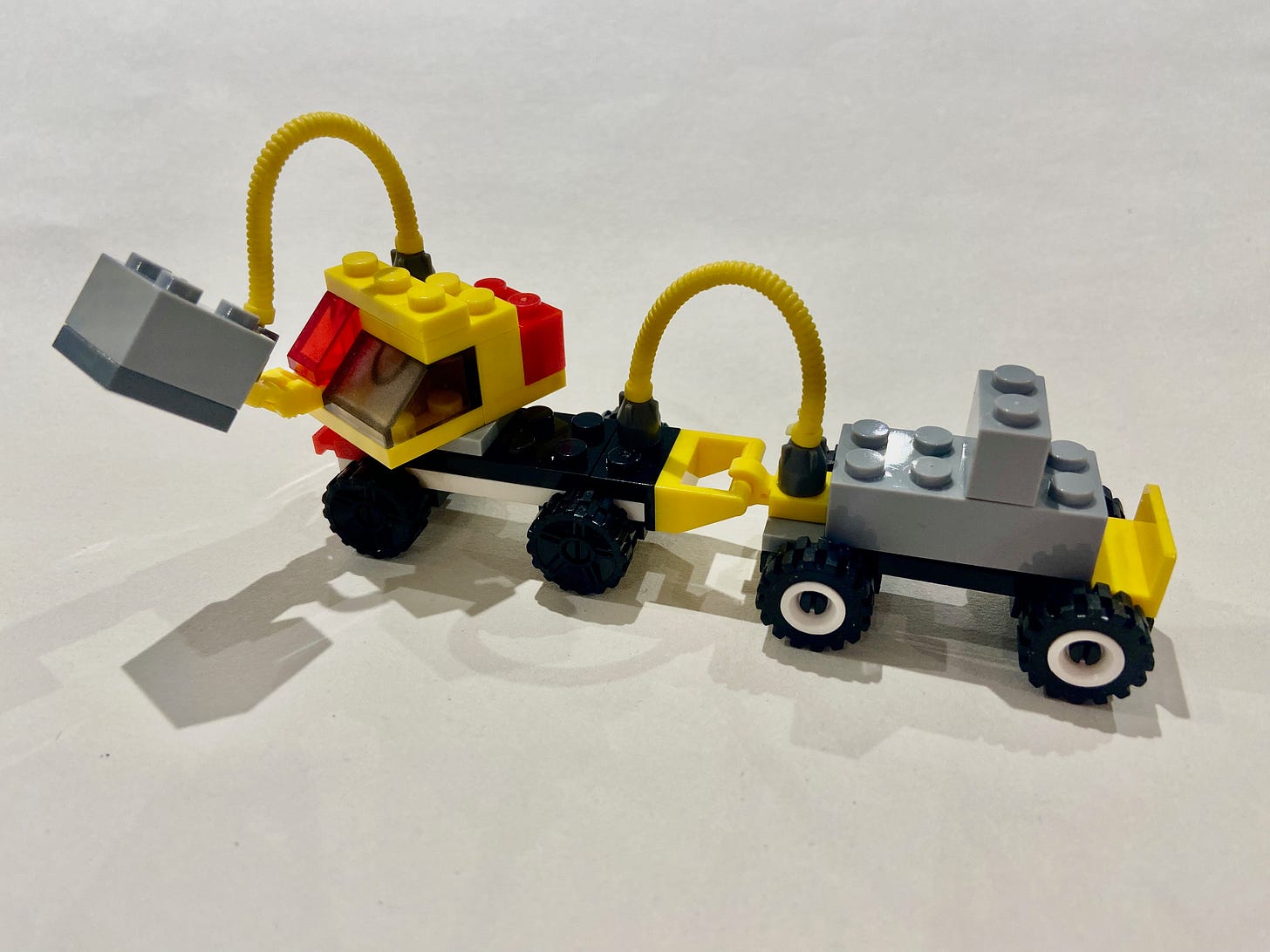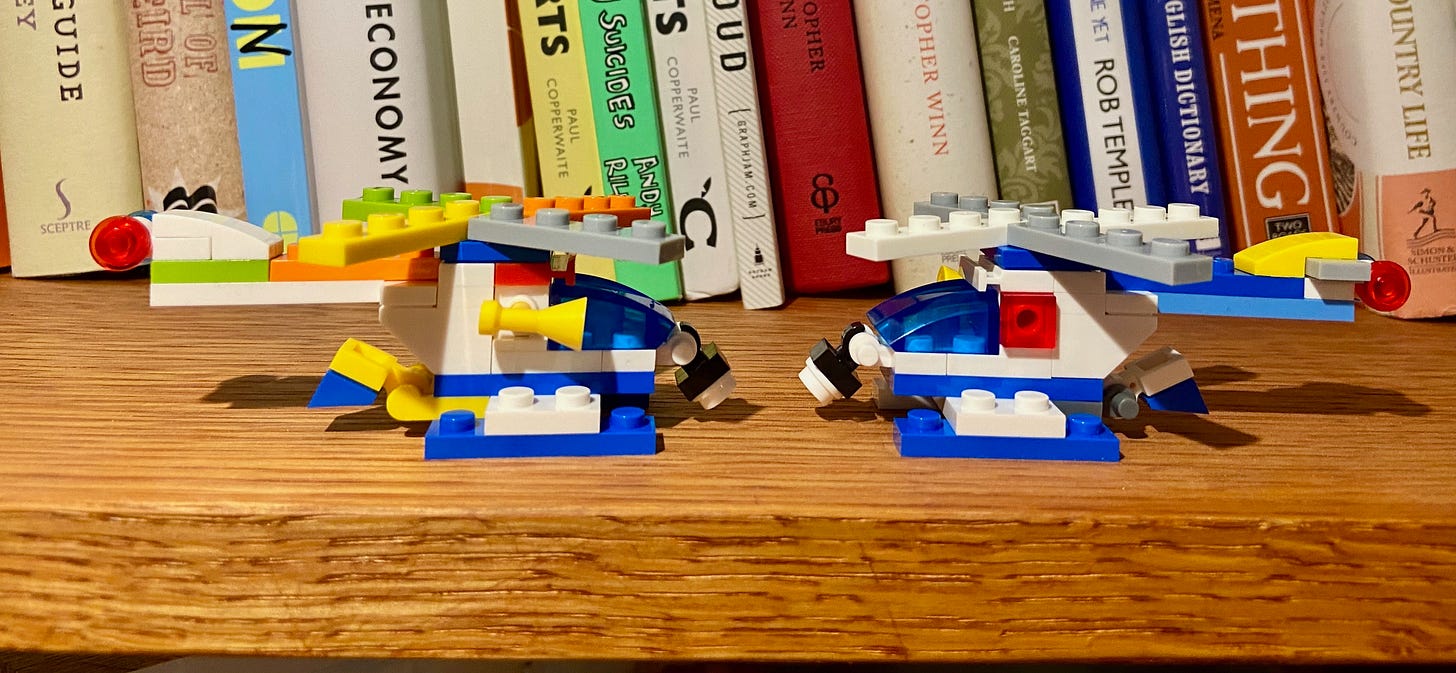In which Rebecca looks back at Lego and the benefits of a shiny floor.
Q: How do you get two very small children to buff a cork-tiled floor?
A: Tie a teatowel to each of their feet and tell them to ice-skate.
Dear Reader,
We don’t often get snow where I live. On the rare occasions when enough snow had fallen for school to be closed – which the south-east of Britain might deliver a couple of times every winter – we’d go sledging on the golf course, or down the long, long slope in Park Wood.
If it had snowed but school wasn’t closed we knew we had to wear our wellies1 in order to be allowed to play outside at break time.
Bordered by criss-cross wire fencing to ensure that no balls – or indeed anything else – could stray, the playground was hard, cold tarmac painted with lines marking it out as a netball pitch. In a heavy frost, or if any fallen snow had deigned to settle, within the first ten minutes of morning break the tarmac would be a sheet of glittering ice smoothed by a couple of hundred small feet.
Thanks to world-champion figure skaters Torvill & Dean ice skating was all the rage for a small child in the 1980s, and I imagined our glasslike playground as an Olympic rink to glide on. I pictured myself wearing skates, not wellies, and of course a gorgeous costume.
Ah yes, a costume. Our school uniform included a grey woollen cape, and on chillier days I’d put mine on by crossing the ribbon neck straps across my chest and around the back of my waist, securing them with a bow. Once its buttons were fastened the cape turned me into a grey triangle with my head poking out of the top, and I liked that my hands and wrists would be cosily invisible unless I popped them through the vertical slits halfway down its front.
Reader, capes made great costumes for ice skaters. Tearing about on the slippery playground we’d be plenty warm enough, so we’d undo the buttons and leave the crossed ribbons tied, our capes streaming out behind us.

And I didn’t only skate at school. There was great excitement at home one weekend after my parents had finished laying cork tiles on the chipboard floorboards of our bedrooms, and my brother and I were given the job of buffing the polish they’d added to protect the surface.
How do you get two very small children to buff a cork-tiled floor? Well, it’s easy: you just tie a teatowel to each of their feet and tell them to ice-skate.
Although we were on our cork rink simultaneously, unlike Torvill and Dean my brother and I skated solo. We carried on for what must have been hours even after every trace of surplus polish had been wiped off on our feet, and the whole time our favourite song played over and over again on our shared record player.
Over forty years later every thought I have about my brother is accompanied by the same soundtrack:
Hot Butter were an American instrumental band best known for their 1972 version of the Moog synthesiser instrumental song Popcorn originally recorded by its composer, Gershon Kingsley, in 1969. Taken from Wikipedia.
What shall we do now that we’ve finished polishing the floor with our feet? 🤔
Of course a smooth, uncarpeted floor is the perfect surface on which to play with Lego, and in my brother’s bedroom was enough space to build a decent-sized town using large flat grey ‘street’ sheets.
The layout would be different every time we set it up, but it would always be a proper square or a rectangle, even if our chosen configuration meant that some of the sheets had to be omitted for our town to make navigable sense.2
The street sheets included a crossroads, a couple of t-junctions, plenty of bends in both orientations and enough stretches of straight road to mean that some judicious jiggling of the boards would tip our cars downhill in at least an approximation of a straight line.
I’d always put my cars astride the lines on the road. ‘That’s wrong!’ my brother would tell me. ‘You need to put them on one side – that’s where they go in real life.’ Always deeply concerned about balance and symmetry, this really bothered me. ‘No, they have to go in the middle!’ I’d protest.

My brother’s building projects always bore close relation to real-world objects, whereas I would take a more laissez-faire approach. No car of my childish construction ever had a windscreen because those narrow, all-transparent pieces would be too hard to find in the old blue drawstring laundry bag which held our Lego. We’d take it in turns to rummage around at the bottom of the bag for exactly the bits we were looking for.
It would be the scrabbler-of-the-moment’s job to seek out their playmate’s pieces too, and we had a certain Lego lexicon in order to identify them.
‘Blue sixer!’ I’d call out. Or, ‘skinny white flat bit’!
Can you get me some red one-ers?’ my brother would ask.
‘Okay, square or round?’
‘Round – I need them for chimney pots!’
Dwellings would be built on thick green base pieces, but it had struck me pretty early on in my construction career that by adding some wheels to the base of any house I’d built I’d have one that was mobile!
Once I’d selected campervan design as my Lego major I no longer needed to fashion pitched roofs for my houses, and instead I took to adding a flat base piece to the top of my four walls. As base pieces were green, the roof of any Rebecca-constructed campervan became a garden by default. I’d populate the green oblong with sticky-uppy lollipop trees and their conical relations, and edge it with criss-cross red fencing.
Reader, all of these vehicles would be driven right down the middle of the road.
In the run-up to Christmas I stumbled on utter gold thanks to what had begun as an online shopping red herring. Looking back fondly at the easy independent companionship3 I had shared with my brother building Lego all those years ago I felt that I needed to get one of these each for everyone to open at Christmas:
I chose one for each family member in what I hoped was their favourite colour, and although each box included three individually-packaged toys to construct, for good measure I also added a packet of random bricks to my order in case anyone wanted to go off-piste with their own construction projects.
Hoping that in a crowd ranging in age from their forties to their seventies nobody would take offence at the minimum age recommendation printed on each box, I handed the goodies to their recipients. There was one for me too, because there was no way that I was going to miss out on the fun.
And it really was fun. The mugs were examined then put to one side while those tiny packets containing toy parts were opened. Construction began immediately, concentration broken occasionally as tiny pieces dropped onto laps or into the melee of wrapping paper and mince pie4 crumbs. With occasional moments of muttering, everyone got stuck in with what they were doing in the solitary satisfaction of working alone in company.
Results were compared. Most of us had followed the printed layouts for the three toys, another had opened up all of his at once and mixed the pieces together, and one family member had made a point of ignoring the instructions altogether in favour of ramping up the spec on his bulldozer and helicopter.
It seems that my brother’s building prowess outweighs my own even today. If any proof of this were needed, he even made these awards:
Although we were six for Christmas, just as my brother and I had skated, built and played on that shiny cork-tiled floor, we took time to enjoy being occupied solo in our cordial companionship.
Reader, it was great.
With love,
Rebecca
📚 Reading 📚
📚
wrote about actual ice-skating this week in the latest edition of . Have a read – it’s delicious!📚
of shares her writing process, creative blocks and progress right here on Substack, as well as on YouTube (where I first came across her work), TikTok and Instagram. Helen is the one I have to thank for first showing me the way to Substack, and I enjoyed this recent post of hers (my favourite line: ‘So what if the table wobbles?’) in which she explores why it’s important to show up without worrying too much about how you feel about it:📚 It won’t be news to regular readers that I’ve been taking time to rest recently, and although I haven’t been doing as much reading on Substack in the last couple of months as I had been, I am – entirely accidentally – spending more hours reading books than I used to. I was thrilled to find this post by
of , which is bursting with tips on how to add more reading to your life on purpose.📚 Regular readers of ‘Dear Reader, I’m Lost' will be no strangers to my ongoing light-hearted correspondence with fellow Brit
of . It’s my turn to reply to him next Wednesday!If you’ve enjoyed this post, please let me know by clicking the heart. Thank you.
And thank you for reading! If you enjoy ‘Dear Reader, I’m lost’, please share and subscribe for free.
A Wellington boot, often shortened to ‘welly’, and also known as a gumboot, rubber boot or rain boot, is a type of waterproof boot made of rubber.
Taken from Wikipedia.
💡 Is this is the origin of my navigation problems? 🤔 Just a theory. 😉
Oxymoron, much? There is a lot to be said for being a solopreneur, even (or especially!) in company.
A mince pie (also mincemeat pie) in North America, and fruit mince pie in Australia and New Zealand) is a sweet pie of English origin filled with mincemeat, being a mixture of fruit, spices and suet. The pies are traditionally served during the Christmas season in much of the English-speaking world.
Taken from Wikipedia.














Happy, happy sigh! I have a HUGE smile on my face. My sister and I are on the phone talking to each other. We just each played Bolero - Torvill and Dean were such extraordinary skaters - I still get goosebumps. And then the Lego! My brother and his partner actually enter Lego competitions and get prizes!! What a fun read. We’ll get back to talking to each other soon, but we had to enjoy this precious post. Thanks SO much. 🤗🤗❄️❄️
Happy memories! I loved Lego (I used to make cars), the popcorn song and torville and Dean. In my younger days I used to go ice skating myself, where what I lacked in finesse was made up for by speed, and an unerring ability to knock several people down like skittles --because I never worked out how to stop.